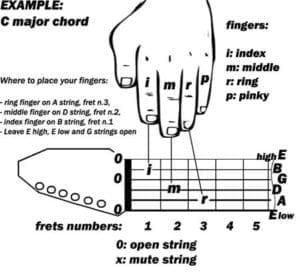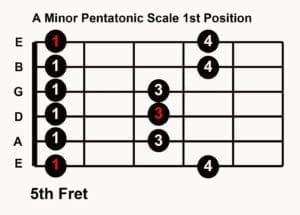Last update 5/2/2024
You’re a beginner just starting to learn how to play the guitar. There may be many things about the whole deal that may seem a bit overwhelming to you. For many players, the idea of learning to read sheet music or guitar tablature can be one of them.
Table of contents
- Guitar Tablature Definition
- How to Read Guitar Tablature Symbols
- How Does Guitar Tablature Work
- Sheet music
- Pretty easy, right? It is just that simple!
- How to Read Guitar Tablature Chords
- Pros and cons of guitar tablature
- Pro – Simplicity
- Pros – Exact note positions
- Cons – Timing
- History of Guitar Tablature
- Conclusion
And, truthfully, for a good reason. Let’s be completely clear here, though. Learning how to decipher all of those guitar tablature symbols can benefit you as a guitar player, especially if your goals are to play professionally (particularly studio work and ‘paid sideman’ gigs).
But…wow…what an undertaking. Hopefully, you get the picture here, especially when you have your hands full learning about chords, scales, solos, and phrasing.
Luckily for the majority of guitar players out there, there is. It’s called ‘guitar tablature’ (‘tab’ for short). While it may not be a perfect substitute for sheet music, it can get you where you need to go. It’s intuitive and straightforward. It doesn’t take all that long to get the gist of how it works.
Guitar tablature, often referred to as “tabs,” is a visual notation system used by guitarists to represent music in a way that’s easy to understand and play on the guitar. Unlike traditional sheet music, which indicates pitch and rhythm through musical notes, guitar tablature uses numbers, symbols, and lines to show which strings to play and where to place your fingers on the fretboard. Tabs are especially popular among beginners and those who want to learn how to play songs on the guitar quickly.
We promise you’ll only take a few minutes to ‘get it’!
Guitar Tablature Definition
In simple terms, “guitar tablature” refers to a visual notation system used by guitarists to represent music in a way that’s specific to the guitar. It uses numbers, symbols, and lines to indicate which strings to play and where to place your fingers on the fretboard. This notation method is widely used to transcribe and share guitar music, making it accessible to players of all skill levels.
How to Read Guitar Tablature Symbols
Learning how to read guitar tablature symbols is like unlocking a secret code that lets you play your favorite songs. Tab symbols represent specific techniques, such as slides, bends, hammer-ons, and pull-offs, each contributing to the unique sound of a song. This comprehensive guide breaks down these symbols, providing step-by-step explanations and visual aids to help you confidently navigate and incorporate these techniques into your playing style.
How Does Guitar Tablature Work
Guitar tablature translates musical ideas into a format specifically tailored to the guitar’s unique layout. Each line on the tab corresponds to a guitar string, and the numbers on these lines indicate which frets to press down on. Players can recreate melodies, chords, and solos by following the sequence of numbers and symbols. Guitar tablature serves as a bridge between the musical concept and the physical execution of the guitar.
Whether you are looking at the latest issue of your favorite guitar magazine or you are surfing the internet on one of the bazillion guitar tab sites. Before long, you’re going to come across a host of various diagrams that will look something like the one below:


Sheet music
It seems crazy, right? It’s not. We’ll do a quick breakdown of all the components. You’ll quickly see how easy it is to understand how it works.
The top portion is typical sheet music. Don’t fear it, though! You don’t have to understand how to read it to use the tab. It’s not uncommon to see it here; it is an excellent reference to the actual tab.
The bottom lines are where the tab lives and breathes. Actually, it’s a simple graphical view of the guitar itself. The six horizontal lines are meant to depict each of the six strings on your guitar. The lines at the top represent the high E (thinnest) string. The bottom line shows the low E (thickest) string. It makes sense, right?


One difference that the tab has compared to sheet music is that there are many numbers instead of dots. That’s how you know where to put your fingers on a particular string to play a note. (or notes…more on that to follow). In our example above, you’ll see that the first two numbers (5 and 8) are on the bottom line. That means you play two notes, one right after the other. First, you play the note on the 5th fret of the low E string, then play the note on the 8th fret of the same string.
Fingers on the guitar naming convention


Pretty easy, right? It is just that simple!
Furthermore, your following two notes are on the 5th and 7th frets of the A string. Then the 5th and 7th frets of the D string, and so on.


Put all of the single notes in this exercise together, and you’ve just played an A minor pentatonic scale. All without having to read a single note of sheet music or having to dig heavily into a ton of music theory!
Just as a side note (no pun intended., If a string is to be played open, you’ll see a ‘0’ for the number.


How to Read Guitar Tablature Chords
Reading guitar tablature chords involves understanding how to interpret chord diagrams within tab notation. Chord diagrams visually depict where to place your fingers on the fretboard to create specific chord shapes. This guide breaks down the components of chord diagrams, explains how to read them within tablature, and provides exercises to help you master the skill of playing chords using guitar tab notation.
Sure, we all love a great guitar solo. Truth be told, soloing typically is a relatively small percentage of what a good guitarist plays. So how can Tab show you how to play chords?
Take a look at the numbers at the very end of our example:


See how all of the numbers are on top of each other? It’s the same thing as the sheet music above. When more than one number is stacked vertically on top of each other, all of those notes will be played simultaneously.
We have an open position Am chord, which perfectly matches our A minor pentatonic scale.
Pros and cons of guitar tablature
Just as with anything, there are pros and cons to using the guitar tab. In our opinion, the pros outweigh the con., However, we would be doing you a disservice if we didn’t lay things on the line…


Pro – Simplicity
Do you see how powerful guitar tabs can be? It’s an excellent tool that many guitar players of all skill levels have used to quickly learn how to play a particular song or guitar solo. The ease and simplicity of hitting the ground running is probably the biggest’ pro’ to reading it correctly.
Pros – Exact note positions
It may be helpful to say that traditional sheet music works best for an instrument like a piano. Why? There is mainly only one key on a keyboard that plays a particular note. A guitar is different because many locations play the same note with the same pitch.
For example, the same E note is the same pitch – not an octave. It can be played on the 12th fret of the E string, the 7th fret of the A string, and the 2nd fret of the D string. Sheet music doesn’t make that distinction. However, on a piano, a specific note refers to a particular key on the keyboard. The guitar tab considers the guitarist’s viewpoint and shows you exactly where to play.
Cons – Timing
Not to be a downer here. There is one particular area where the guitar tab may be lacking. As a total solution for learning to play a specific piece of music., it does have shortcomings.
One thing that tab doesn’t do very well, actually, not at all. The tab does not show the duration and timing of a note. Sheet music is designed by nature, where each type of note depicts how long a note lasts. All you have with the guitar tab is just a number on a line. Yes, it shows you where to play the note. However, it doesn’t tell you how long it’s supposed to ring out.


If you’re trying to learn a song or solo that you already are familiar with. This may not be that big of a deal, as you already have a pretty good idea of timing. Using a tab to play a song you have never heard before is challenging.
This is one good reason to have sheet music on the top. You can use the tab to get the fingering positions right and then develop your reading standard notation as time goes on with practice.
History of Guitar Tablature
The history of guitar tablature is a fascinating journey through time, showcasing how musicians and scribes developed methods to notate music for the guitar. From its earliest forms in Renaissance lute music to its widespread use in today’s digital age, guitar tablature has adapted to various musical styles and technological advancements, preserving the artistry and techniques of generations of guitarists.
Conclusion
Learning to read guitar tablature is a skill that takes little time. However, it certainly can significantly benefit you and your other guitar-playing band members. Gone are the days when you had to know how to read sheet music (which is typically set up for piano, anyway). Or work on developing your ear to figure out a song by listening to it repeatedly…and over…
Sure, it’s not the complete answer or replacement for traditional sheet music. However, it’ll get you pointed in the right direction a lot faster. That alone is worth the price of admission. All that is required is nothing more than taking a few minutes of your time to understand how it works. That is time well spent!
Transparency disclosure: Some of the links in this post are affiliate links, meaning that I may earn a commission if you click on a link and make a purchase. This commission comes at no extra cost to you. We only recommend products and services that I believe are helpful and valuable, and we never let the potential for a commission influence our recommendations.
Amazon: A Complete Guide to Reading Guitar Tab and Performing Modern Guitar Techniques



